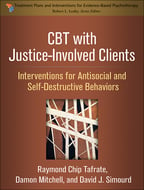
There is an interesting contradiction in the scientific research of justice-involved clients (JICs) as it relates to mental health. First, JICs tend to have a relatively high prevalence of mental health problems. Second, mental health symptoms among JICs are actually weakly related to criminality (i.e., poor predictors of recidivism). Although there are certainly individual cases in which a JIC’s mental health symptoms directly influenced their offending behavior, these are infrequent occurrences. For the majority of cases, criminal risk domains (discussed in our previous blogs) and not mental health symptoms drive criminal behavior. This concept is particularly important in terms of intervention.
Providing mental health treatment is commonly associated with reductions in psychiatric symptoms in the hope that there will be a consequential decline in reoffending. This rarely occurs. Interventions specifically addressing broader lifestyle issues (e.g., routines, relationships, and destructive habits) produce larger reductions in future criminality. Adapting CBT to forensic settings requires a shift away from symptoms, and a more concentrated focus on relevant criminal risk domains.
Making the transition away from mental health towards risk domains is often a difficult shift for practitioners. First, there is the natural desire to want to alleviate psychological distress and help JICs feel better. A mental health intervention strategy, under the best of circumstances, will require time to achieve a degree of symptom relief (usually weeks); time the JIC might not have if they are actively engaged in risky activities and self-defeating decisions. This is one of the critical differences between working in forensic settings compared to mental health settings. Mental health clients can falter and get back on track. For JICs, one mistake, a momentary “lapse of judgement,” or a “bad day” can have a serious impact on the person’s life trajectory. Of course, nothing is likely to make JICs’ mental health problems worse than getting incarcerated or re-incarcerated. The reality is that if your heart is in the right place, then addressing those factors that put your JIC most at risk for re-arrest is your first priority. Symptom reduction will often have to take the back seat.
Several of us are clinical psychologists whose main way of approaching cases revolved around a symptom-based approach. When we began working with forensic clients, it took a long time to make the transition from a symptom-based to a risk-based mindset. We found the exercise below to be personally helpful.
Try This Personal ExperimentWhether we admit it or not, we all do dumb things and make mistakes from time-to-time. Most of these “lapses of judgment” don’t cause much harm to us or others. Some common examples of the subtler types of “lapses of judgement” include:
Think of a recent example in which you did something like that or something else that was potentially harmful to yourself or others. Think about whether your “bad” behavior was driven by feelings of worry or sadness. Also, think about whether your actions were more related to certain contextual, social, or dispositional factors such as your personal history, attitude toward a situation, desire for excitement or fun, peers and social influences, pursuing your own self-interest, and so on. At this point you should now be thinking: “Okay, I get it; mental health was not the key issue, but risk factors were.” |
Of course, this is an analog experiment and specific scenarios will vary from person to person, but the point is that mental health symptoms are not as central to antisocial behavior as many practitioners may believe. When we do this exercise in our training workshops, we have found that the vast majority of participants do NOT attribute recent examples of their “bad behavior” to symptoms; the opposite occurs with most people identifying lifestyle and situational factors as more influential in accounting for their “lapses of judgement.” To be fair, some people acknowledge that a mix of symptoms and other life factors played a role in their decision-making and a small minority attribute their poor behavior solely to mental health issues. The point of this analog experiment is to illustrate that our own bad behavior is a good reflection of what happens with JICs in the real world.
Finally, there is the issue of expertise. It is our view that community corrections officers and case managers are not experts in treating mental health problems. We agree with the argument that probation and parole officers should not drift too far into the roles of psychologists, social workers, or therapists. However, JICs typically have a high rate of mental health problems which means correctional personnel should be able to recognize and screen for mental health disorders, locate community resources, and make appropriate treatment referrals. This is certainly pertinent to working with this client group. As noted earlier, however, addressing mental health symptoms is considered an adjunct to, not a replacement for, addressing criminal risk domains.
 What works and doesn’t work when using Cognitive-behavioral therapy (CBT)? This is something the authors, Raymond Chip Tafrate, PhD, Damon Mitchell, PhD, & David J. Simourd, PhD, of this blog series have spent a long time studying and have put all they’ve learned in the book: CBT with Justice-Involved Clients: Interventions for antisocial and self-destructive behaviors. We thought our subscribers would be interested in a blog series on this content, knowing so many use or refer their clients to this type of treatment. Therefore, we are pleased to announce a blog series on Adapting CBT for Justice-Involved Clients.
What works and doesn’t work when using Cognitive-behavioral therapy (CBT)? This is something the authors, Raymond Chip Tafrate, PhD, Damon Mitchell, PhD, & David J. Simourd, PhD, of this blog series have spent a long time studying and have put all they’ve learned in the book: CBT with Justice-Involved Clients: Interventions for antisocial and self-destructive behaviors. We thought our subscribers would be interested in a blog series on this content, knowing so many use or refer their clients to this type of treatment. Therefore, we are pleased to announce a blog series on Adapting CBT for Justice-Involved Clients.
The trajectory of the science and practice of cognitive-behavioral therapy (CBT) models began with a focus on internalizing mental health syndromes such as depression and anxiety and was later extended to externalizing problems such as substance misuse, anger dysregulation, and personality pathology. Although CBT has grown into a large collection of interventions applicable to diverse client groups, attention to justice-involved clients (JICs) is substantially more limited. This is noteworthy because CBT has been found to be effective in addressing the self-destructive patterns common among JICs. This suggests that interventions using CBT techniques can alter the criminal risk potential of JICs, which in turn may lead to less risky decision-making and behaviors, and ultimately a safer society.
The practical application of any intervention approach often requires adaptation when delivered to a unique client group; and this occurs with CBT and JICs. We have been fortunate to have been involved in vast activities with JICs over the years. This has included developing and implementing intervention programs, providing training, consultation, and direct service to JICs. We have also worked with front-line criminal justice personnel in both custody and community settings. CBT techniques have been a constant theme in all our work with JICs and criminal justice personnel. Along the way, we have refined what works, eliminated what didn’t work, and examined the impact the interventions had on recidivism. In this blog series we will discuss what we have learned about tailoring CBT when working with JICs within a community corrections context.
|
Raymond Chip Tafrate, PhD |
Damon Mitchell, PhD |
David J. Simourd, PhD |
* These blogs are meant to present brief tips and strategies for agencies, programs, and practitioners. Readers who want more science, history, or detailed descriptions of “how to” conduct forensic CBT interventions may consider the following resource: CBT with justice-involved clients: Interventions for antisocial and self-destructive behaviors.
** There are many terms commonly used to describe people receiving services in criminal justice settings: offender, juvenile delinquent, probationer, parolee, prisoner, inmate, court mandated client, and patient, to name just a few. We commonly use the term justice-involved client (JIC). The abbreviation JIC is not intended to communicate any notion of inherent badness; instead, it’s meant to convey the complexities and challenges associated with the larger context in which intervention is delivered, while sidestepping the pitfalls of pejorative labels.




